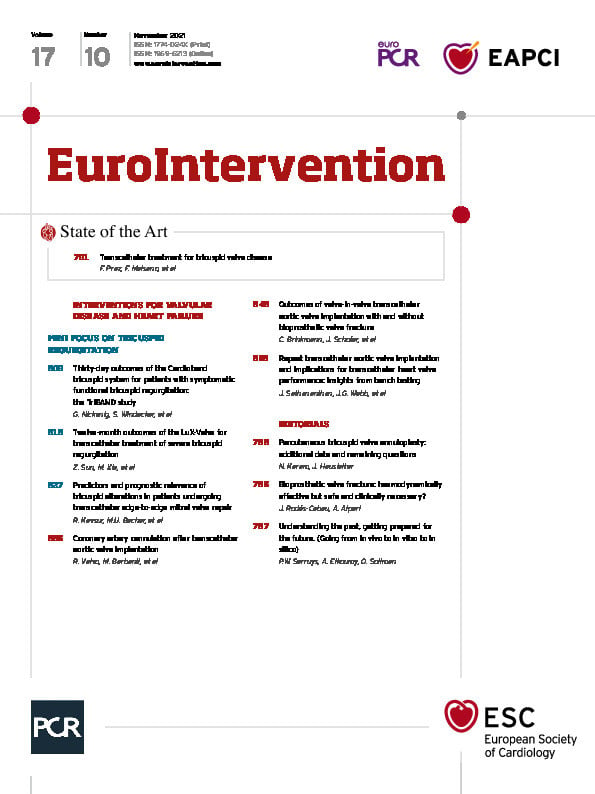Valve-in-valve transcatheter aortic valve implantation (VIV-TAVI) has become the preferred treatment for the majority of patients with surgical aortic bioprosthesis dysfunction. While VIV-TAVI is associated with significant clinical improvements in the majority of patients, a high rate of suboptimal haemodynamic results defined as a residual gradient ≥20 mmHg has been reported, particularly among patients with small stented surgical valves. Bioprosthetic valve fracture (BVF), which consists of fracturing the ring of the surgical valve using a high-pressure non-compliant balloon, has emerged as a technique for improving valve haemodynamics following VIV-TAVI1. However, data on BVF have been limited to small series with limited follow-up and no control group.
In this issue of EuroIntervention, Brinkmann et al2 report the results of a multicentre retrospective study including 81 patients who had VIV-TAVI+BVF compared to a group of 79 patients who underwent VIV-TAVI without BVF.
The two groups had a similar high-risk profile, but major imbalances were observed regarding surgical valve type and size, mode of valve dysfunction, and transcatheter valve system type. Unfortunately, no data were provided on the criteria for implementing BVF, consecutive patient inclusion, and BVF success rate. BVF was associated with a lower mean residual gradient (~11 mmHg vs ~16 mmHg in the no-BVF group) and no increased mortality/stroke/pacemaker/coronary obstruction complications. However, 3 patients (4%) had major mechanical complications related to BVF, including 2 cases of ventricular septal rupture (managed medically) and 1 case of severe valvular regurgitation (managed by implanting a second transcatheter valve). Also, BVF was associated with a significant increase in procedural and fluoroscopy time, and a tendency towards a higher contrast amount. After a mean follow-up of 9 months, valve haemodynamics, as evaluated by Doppler echocardiography, remained stable in both groups.
Feasibility and efficacy of BVF
The data from Brinkmann’s work further confirm the haemodynamic efficacy of BVF in the context of VIV-TAVI. While no data are provided on the amount of transvalvular gradient reduction associated with BVF, the lower residual gradient (mean difference of 5 mmHg) in the BVF group translating into a much lower device failure rate reflects the direct positive haemodynamic effects of such a technique. However, the suboptimal results obtained with BVF in patients with a Mitroflow surgical valve (Sorin Group, Saluggia, Italy) highlight the fact that BVF cannot be successfully applied to all surgical valve types. Future studies should provide more details about the degree of gradient reduction following BVF according to surgical transcatheter valve type.
Safety of BVF
While the number of patients/events was too limited to draw definite conclusions regarding the safety profile of BVF, the lack of any increase in major complications such as stroke and coronary obstruction was reassuring. However, embolic protection devices were used in up to one third of BVF patients (vs <10% in non-BVF patients), and this may have played a role in such results. Also, techniques for preventing coronary obstruction were more frequently used in BVF patients. In addition to the prolonged procedural/fluoroscopy time and direct cost of the non-compliant balloon, the costs and risks of all concomitant techniques should also be considered when evaluating the overall cost-effectiveness of BVF in VIV-TAVI (vs no-BVF or surgical redo).
The 4% rate of mechanical complications (2 cases of ventricular septal rupture, 1 case of severe valvular regurgitation probably related to valve leaflet evulsion) directly related to BVF is of concern, particularly considering that previous VIV-TAVI series did not report any case of annular or ventricular septal rupture or leaflet damage3,4. Future studies will need to evaluate the optimal degree of balloon oversizing in order to minimise the potential risk of mechanical complications. Also, performing BVF before implanting the transcatheter valve would prevent valve leaflet damage, but an aggressive dilation of a severely diseased valve prosthesis may increase the risk of embolic events and a potential leaflet evulsion leading to massive aortic regurgitation with haemodynamic consequences.
Clinical utility of BVF
The most important drawback of BVF relates to the lack of data on its clinical usefulness and, unfortunately, the work from Brinkmann et al also failed to provide any data on the clinical benefits of such a technique. Recent data on the long-term outcomes after VIV-TAVI failed to show any negative impact of higher residual gradients3, and the largest series of VIV-TAVI published to date did not show any clinical differences (mortality, quality of life improvement) at one-year follow-up according to the residual transvalvular gradient4. These data would question the 20 mmHg cut-off for determining device success/failure in VIV-TAVI procedures and suggest that the modest haemodynamic benefit obtained from BVF may not translate into any clinically relevant improvement. Also, some discordances between haemodynamic results and clinical outcomes in the VIV-TAVI field may be partially explained by the fact that Doppler echocardiography measurements do not take into account the “pressure recovery” phenomenon, which translates into a frequent overestimation of the residual gradients as evaluated with echocardiography versus catheterisation measurements5.
In conclusion, Brinkmann et al should be congratulated for their work, which represents one of the largest series of BVF and the first to provide comparative data. Their results confirm the efficacy of this technique regarding valve haemodynamics. However, despite an overall good safety profile, the possibility of mechanical complications associated with BVF raises concerns about its risk/benefit ratio, particularly considering the lack of data about its potential beneficial clinical impact. While waiting for additional data, limiting the use of BVF to selected cases and only after a careful evaluation of valve haemodynamics (including heart catheterisation pressure measurements) would probably be advisable.
Conflict of interest statement
J. Rodés-Cabau has received institutional research grants from and is a consultant for Edwards Lifesciences, Medtronic, and Boston Scientific. A. Alperi has no conflicts of interest to declare.
Supplementary data
To read the full content of this article, please download the PDF.

